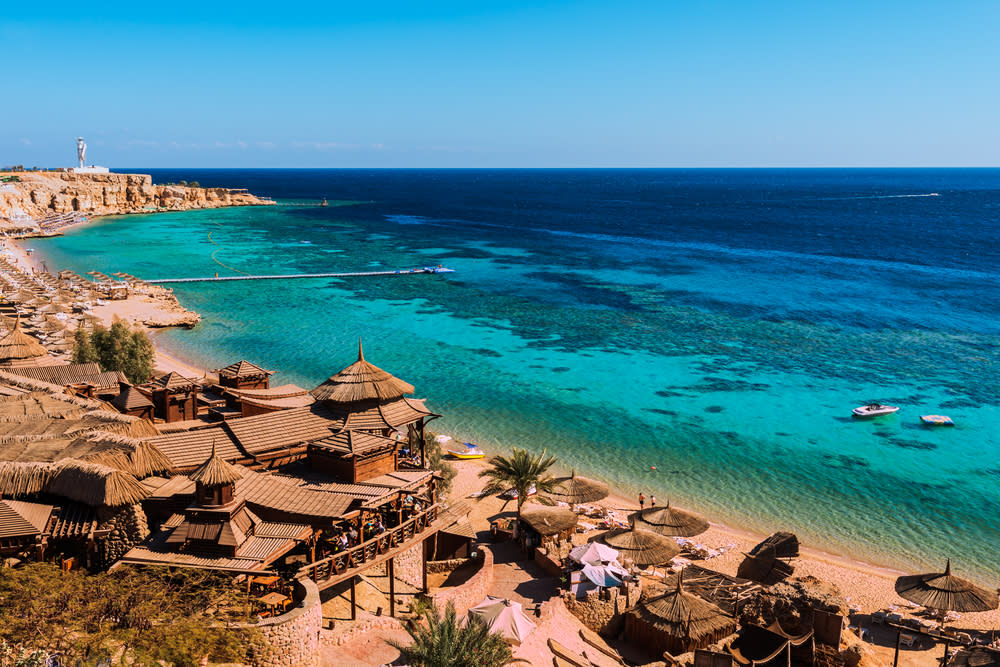More from Red sea
Main Menu
- 00:00
- 06:00
- 12:00
- 18:00
- 23:00
Red sea : Next 24-Hour Weather
Today - 22nd February 2025
Sunrise 06:17
Sunset 17:47
Tomorrow - 23rd February 2025
Sunrise 06:17
Sunset 17:47
Holiday Weather Now
Sorted by popularity:
Updated at 14:01 GMT
-
Temp feels like21°C70°F
-
Length of day11h 30m
-
Pressure30" (1017 hpa)
-
Visibility10 km (6miles)
-
Wind speed22 km/h
Sunrise 06:17
Sunset 17:47
-
Temp feels like:
21ºC (70 ºF)
-
Length of day:
11h 30m
-
Pressure:
30" (1017 hpa)
-
Visibility:
6 miles (10 km)
-
Wind speed:
22 km/h
Marsa Alam has a hot and extremely arid climate. Its high temperatures are somewhat moderated by the waters of the Red Sea. The desert climate is typified by a constant drought, large drops in temperature at night and almost endless sunshine. Marsa Alam was until recently a small fishing village but is rapidly becoming a favourite tourist destination. It sits on Egyptâs east coast on the Red Sea.
Summer, from April till October, is baking hot. The average high temperature climbs steadily from 30°C in April to a peak of 35°C in July and August, before sauntering back down to 32°C in October. Night time lows in the mid 20s, while relatively much cooler, are hard to handle. If youâre on a budget, it is highly unadvisable for air-conditioning to be a factor up for compromise. The sun beats down relentlessly. Luckily, Marsa Alam is right on the Red Sea and is often quite windy. The winds help to make the heat more bearable as do low humidity and regular dips into the vast salt lake. Marsa Alam is relatively cool in comparison to inland regions of Egypt away from the water; while the temperature can get into the 40s, in Luxor 40°C is the average high in peak summer. It is unadvisable to stay out in the sun for too long, risk of sunburn, sun stroke and dehydration are high.
Diving, is better suited to the summer season due to the 30°C water and calmer seas. This allows for prolonged dives, easier swimming and exceptional visibility.
Winter, from December till March, is milder and the best time to visit the area if youâre planning to lounge endlessly on the beach, though choppy waters and high winds are detrimental to diving conditions. The average high temperature drops to the mid 20s, dipping down to 23°C in January. Night times are refreshingly cool around 14°C. The sun remains out almost continuously and it stays dry. October is the resortâs wettest month and sees a staggering 3 mm of precipitation on average. Sandstorms rarely blow over from the desert regions of the country and the rest of Africa. They are most likely at the end of winter in March and are carried by the khamsin wind which is hot and sand-bearing.
Marsa Alam owes its climate to the Red Sea and to the Atlas Mountains which starve much of Northern Africa of rainfall. The resultant desert stretches over much of the continent. Low humidity results in insolation, the opposite of insulation, which can be observed in the huge difference in temperature from night to day. If it were not for the Red Sea, Marsa Alam would experience the extremes of desert temperatures. The waters cool the shore and encourage wind to blow inland. However, this effect is minimal and does not reach far inland. Marsa Alam is the furthest south of Egyptâs Red Sea resorts and as a result sees a shorter winter period. The desert climate has resulted in desert terrain, with sparse vegetation in the form of palms and grasses hugging the shore. However, a step into the Red Sea will open up a stunning world of thriving biodiversity; newly discovered as a tourist location, the coral reef near Marsa Alam is pristine. The wildlife that throngs all about it is varied and often quite rare. Many species of dolphin are to be found and, more famously, Marsa Alam is a place to see dugongs, also known as sea cows, which are highly endangered.

















